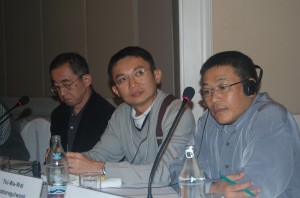By Lynette Lee Corporal
Cartoonists and photojournalists usually let their work speak for them, so when they actually meet with their audiences, expect to see a Standing Room Only crowd.
In a session on ‘The View from Cartoonists and Photojournalists’ that elicited both chuckles and pensive silence from the audience at the Mekong Media Forum, cartoonists, illustrators and photojournalists from Thailand, Burma, China and Japan talked about how they mix art with social commentary.
Drawing from their interpretations of their work — be it a series of photographs, a set of illustrations or editorial cartoons — the speakers were quite vocal about how certain issues and experiences have shaped their perceptions of their countries.
“Doing watercolour illustrations is my way of telling people about the ways of those living along the Mekong River,” said Thi-wa-wat Pattaragulwanit of his watercolour illustrations. Thi-wa-wat is the editorial cartoonist for the Thai-language daily business newspaper ‘Krungthep Thurakij’ and the English-language daily ‘Bangkok Post’.
Recalling his trips along the Mekong River some 20 years ago, the artist saw its many changes, calling some parts of the 4,880-km long river “beautiful but full of sadness” due to the development plans in the upper Mekong. He expressed concern for China’s blasting of reefs and islets to make the river more navigable after the construction of dams in the upper Mekong.
“Who are the owners of the Mekong River? How can anyone justify the blasting of boulders in the river?” he asked.
Soe Win Than, a photojournalist from Burma, shares Thi-wa-wat’s environmental bent. His change of heart happened when he saw the extent of deforestation in his own country while reporting on an assignment.
Burmese cartoonist Harn Lay of the Chiang Mai-based ‘The Irrawaddy’ magazine knows how powerful images — whether cartoons or photos — could upset authorities.
He is pragmatic enough to say that cartoons “can’t change politics” but that it also holds up a clear mirror image — a humorous one at that — of what’s happening in a country.
“It’s more difficult to make people think so we have to think hard how to be funny and give the people something to think about too,” he said, drawing laughter from the crowd for the satirical images that poked at socio-political issues related to Burma.
For photojournalist Li Lang and Japanese illustrator Akira Mizuno, a country’s rapid development has never been more clearly defined than in the former’s railway train adventure and the latter’s Vietnam travels.
Li Lang, photography director of ‘Business Travel’ magazine in China, was struck by the 850-km long railway system that existed a hundred years ago and linked Kunming in China to Hai Phong in Vietnam. He documents the remnants of this railway route via photographs and noted how the old train station on the Chinese side had become home to huge and tacky advertisements and high-rise residential buildings.
“In contrast, the train station on the Vietnam side has retained its quaint look and quiet, non-commercial ways,” said Li Lang.
Mizuno’s sojourn in Vietnam — and later on the rest of the Mekong region — enabled him to relive the Japan that he once knew.
“My visit to Vietnam in 1987 opened my eyes to the beauty of the people and their sense of community spirit,” said the Tokyo-based illustrator of over 30 years, who uses watercolour to do his illustrations after taking photographs of his subjects. “Becoming rich is good but getting to be too busy like the Japanese is not. When I do my illustrations, I always hope that I can capture the humanity of society, rather than machine and materials…,” he said.
“If all of us can erase the border of each country with our imaginary rubber eraser, then we can truly be united. (That way) we do not only become citizens of our (respective) countries, but citizens of the planet,” said Thi-wa-wat.








